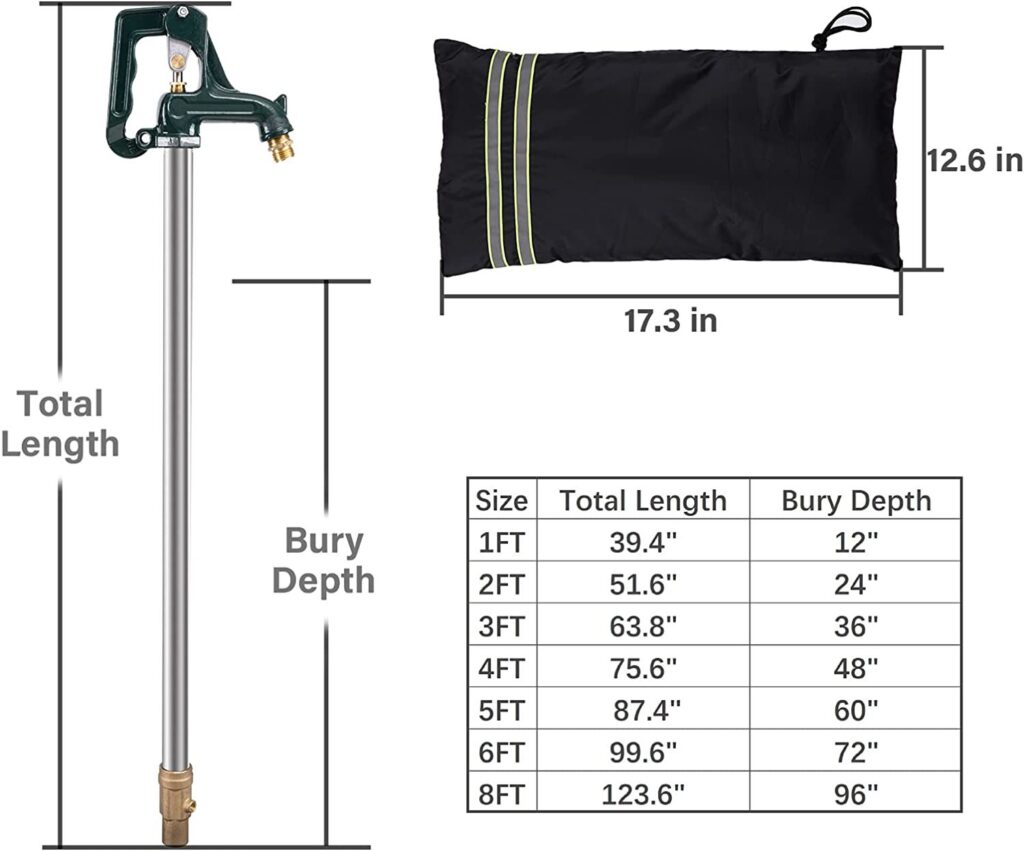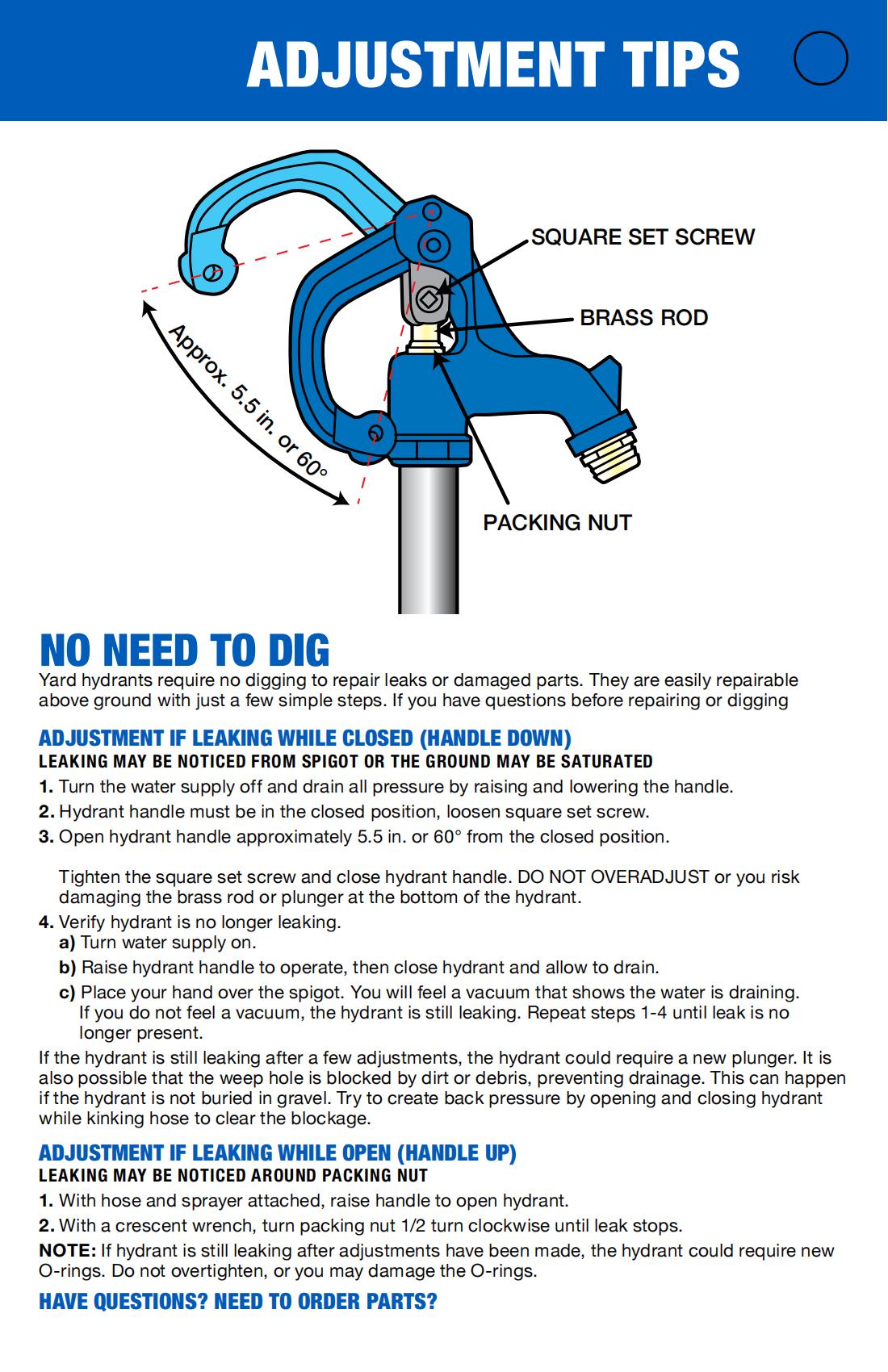Water is an essential element for our survival. The freezing point of water is 0°C. When the temperature reaches this particular point, water will turn into ice. However, there are many regions where the temperature falls to minus or below 0°C. For such places, it is hard to keep water flowing through pipelines.
To deal with this issue, we use frostproof yard hydrants. They save water from freezing and help us access smooth flow without much fuss. Let’s check what a frostproof yard hydrant is.
What is a Frost Proof Yard Hydrant?
A frostproof yard hydrant is a plumbing product that drains water from the ground without letting it freeze. It is also called a water pump, which pumps water from the bottom to the top. These hydrants provide us with non-frozen water throughout the year.
The yard hydrant has an easy-to-understand structure. The head of the hydrant is on the top. It has a handle alongside. The handle has to be lifted when you want to start the flow. Now, the hydrant is operational. Similarly, we need to pull down the handle to stop the flow.

The first proof yard hydrant had a considerable length buried in the ground. It is that point from where water is drained under the frost line. Yard hydrants are generally installed in open areas. Their applications are houses, farms, gardens, etc. They can also serve the purpose of delivering potable water and other uses.
Here are the specifications of a Frostproof used hydrant.
| Specifications. Product: Frost Proof Yard Hydrant. Material: Cast Iron, Galvanized steel. Depth: 5 feet. Overall Length: 96 1/2 inches. Inlet Size: 3/4 inch Outlet Size: 3/4 inch Thread: NPT Max Pressure: 125 Psi. Max Temperature: 120°C. |
Parts Of Frost Proof Yard Hydrant.
Yard hydrants are very durable in their performance. But sometimes, a problem may occur in one of the parts of the yard hydrant. In such a situation, we can replace the damaged part instead of changing the hard hydrant. It will be more convenient and budget-friendly.
Before looking for a part of a frostproof yard hydrant, you must know its details. Below are the parts of the yard hydrant and their essential features.
- Head of the hydrant: The head of the frostproof yard hydrant is the most prominent and essential part. The head comes in varieties, but they all share the same purpose. The handle on the head is responsible for lifting the pipe or rod. It allows water to circulate through the vertical pipe to the head.
The hydrant head comes with an adjustment feature. Its packing contains a nut. If the rod is misplaced, we can fix it with the help of a nut. The nut can also save the day by treating problems like leaks, seeping, etc. Flow control is another option. Using this feature, you can adjust the water flow per your needs. This property is imposing when you aim for a specific flow limit.
The head of the hydrant also has an outlet opening sometimes. It can be connected to some pipelines. This feature is excellent for connecting directly with the hydrant on farms, gardens, or for household purposes.

- Straight Pipe: A vertical pipe starts from the bottom of the head and reaches down into the ground. Usually, galvanized pipes are good to go, and they are commonly used. Yet, if the water content or soil is corrosive, it is better to get a stainless steel or brass pipe. The length of the pipe varies. It can be somewhere between 1 and 8 feet. It remains empty when the water supply is shut off.
- O-Rings: O-Rings are valve assemblies used in frost Proof Yard Hydrants. Observations show that using an o-ring setup gives a good-quality flow. Two or more O-rings arranged sequentially can cut off the water supply. But O-rings have one serious disadvantage. They can wear out very fast and need regular maintenance. In such cases, alternatives are also present.
- Rubber Plungers: Rubber plungers are a good option when O-rings are not performing well. Plungers last for longer without getting damaged. They don’t need to be replaced soon. Yet, plungers come with a steel rod that can be affected by corrosion.
Get a Premium Quality Frost Proof Yard Hydrant here.
How to Install Frost Proof Yard Hydrant?
Installing a frostproof yard hydrant is more challenging than simply installing a plumbing fitting. If you do it for the first time, you must dig a lot of soil. Also, the hydrant has to be connected to the water source. If no supply line is available, we must create a new line towards the hydrant. You can do it on your own or can call a plumber.

Let’s check how to do the installation.
Required Tools:
- Pipe Cutter.
- Shovel.
- Pliers.
- Level.
Required Material:
- Frost Proof Yard Hydrant.
- Male Threaded Adapter.
- 90° Elbow.
- PVC pipe, tee fitting, and solvent Glue.
- Plumber’s tape.
- 1/2 inch Gravel.
Procedure:
(1) Digging the Hydrant location: Turn off the water supply before installing. The initial step is to dig soil at the point where we will install the frostproof yard hydrant near the underground supply. This supply should not be above the frost line. You can check the frost line if you are at Google.
Installation requires enough digging, and we need to make a big hole. It should have enough depth that the hydrant pipe fits well. Be careful about damaging the underground water pipeline, and use a shovel only.
- Fix the Tee Fitting: We must install a tee fitting in the soil and the water supply line. Using the pipe cutter, take out a section of the water supply line at 90 degrees. At this point, we will attach the hydrant apparatus. It will connect the hydrant with the water supply, and we will get access to water. With the help of solvent glue, the short part of the PVC hydrant pipe is fixed with the supply line. Take the level from your tools and ensure the tee fitting and the supply line are perfectly aligned.
- Attach the Adapter: We have attached a short pipe with the main underground supply. Now, it’s time to connect the Elbow to the pipe outlet. We have to fix the adapter here with the help of a plumber’s tape. Right, the adapter with the use of pliers to hold it right. One side of the adapter connects the Elbow, and the second connects the PVC supply.
- Installing the Frost Proof Yard Hydrant: Now fix all. The extra fittings are required by cutting the pipes and adjusting them. Make sure that all fittings are secure and well-settled. Use solvent glue on the hydrant fittings. Wait for the glue to dry.
It is essential to note that the hydrant works before filling the dig with soil. Turn the water supply on and check how it’s going. If everything is sorted, then you are good to go. You can install 1/2 inch gravel to level the drain pipe. Now, you can fill up the hole by putting the soil back. And you are done with the installation process.
How Does a Frost Proof Yard Hydrant Work?
A frostproof yard hydrant works the same way a water pump does. It has a head with a handle that goes down into the earth and connects with the main supply line. The handle controls the vertical pipe, reaching the rubber plunger at the bottom.
When we lift the handle upward, it raises the plunger in the bottom, causing water to come to the top. Water circulates the hydrant pipe and ultimately reaches the outlet at the top. Similarly, when we lower the hydrant handle, water goes down.
When the handle is lowered, the plunger is closed, and the water is not allowed to go upside down. In this case, water remains in the drain of gravel present near the drain valve. This gravel is installed along with the frostproof yard hydrant. Water remains in the surrounding soil and is hindered from going into the hydrant pipe. This working of the hydrant saves water from freezing even in the coldest temperatures.
The most important fact to remember is that the hydrant pipe must lie below the frost line. It is the line after which the water begins to freeze underground. This line lies at different depths for different locations.

Applications of Frost Proof Yard Hydrant:
Frostproof yard hydrants are becoming commonly used every day. It has several types and respective applications. Let’s look at a few applications of frostproof yard hydrants.
- Household Use: Houses are a typical application of frostproof yard hydrants. They are used in areas with very low-temperature records and houses far from the main supply lines. It can be highly beneficial for household use to prevent water from freezing.
- Farms: Farms need regular moderate water throughout the year. A frostproof yard hydrant is very crucial to install on farms. It directly connects with the main supply and gives us non-frozen water. Farms generally use such hydrants on a large scale. Watering plants, feeding animals with water, and fulfilling cleaning purposes is easier.
- Public Residencies: In such places, water is required in a very high amount. Hydrants take the water to the top in an efficient manner. It’s good to install multiple hydrants in consistent areas. It will help the public access water and sustain a water availability environment.
Advantages of Frostproof Yard Hydrants:
Following are the advantages of using frostproof hydrants,
- Hydrants make your water sufficient. You can get water from any tie by pulling the lever or handle upwards. You can install it in the yard and take frost-free water anytime.
- Yard hydrants have opening spouts and threads. It means connecting a pipe with the lines and taking this pipeline anywhere. It makes water carrying easy and convenient.
- The most apparent function performed by the yard hydrant is its temperature resistance. These hydrants are frost-free. You can get flowing water 12 months a year. It is the most exciting feature.

Takeaway:
If you are looking for an easy and efficient way to access water, you must consider frostproof yard hydrants. They have multitasking qualities. Not only will hydrants give water access, but also they don’t let the water freeze throughout the year.
The properties of the yard hydrant are striking. You can get the best sizes and measurements for your yard. These are multi-purpose fittings. Hydrants are easy to install and understand. Their work is simple, and they are cost-effective products. Give hydrants a try, and you will never regret it.
